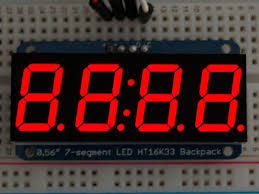All over the world, peoples are working on energy solution. It would be a tough time for our next generation to survive if we don’t think about solution. Tony stark is working on a new project and wants to display his project using “seven segment display - concept”. Tony Stark gave Jarvis a task to find a number from his Favorite list of number for which the energy consumption is lowest.
(Assuming that for a digit to represent Tony stark is using 7 bulbs and only those bulbs light up which are required to represent a number and rest other would be completely off.)
Help Jarvis and conserve energy.
Seven segment display - https://en.wikipedia.org/wiki/Seven-segment_display

Input:
First line will contain the number of test cases and for every test case first line will contain length of favorite list and the second line for a test case will contain n numbers
Output:
For every test case print the answer. If there exist more than 1 numbers for which same number of bulbs are required than output the number which occurs first in the Favorite list.
Constraints:
Test cases< 10
A[i] < 10^6
Size of list < 10^5
SAMPLE INPUT
1
5
1 2 3 4 5
SAMPLE OUTPUT
1
Explanation
Number 1 needs only two bulbs to represent.
Number 1 needs only two bulbs to represent.
Code:
import java.io.IOException;
import java.io.InputStream;
import java.io.PrintWriter;
import java.util.HashMap;
public class Solution {
public static void main(String args[]) throws IOException{
InputReader in=new InputReader(System.in);
PrintWriter out=new PrintWriter(System.out);
int T=in.readInt();
while(T-->0){
long N=in.readLong();
long min=222222222;
long minnum=0;
while(N-->0){
long num=in.readCount();
long count=in.getcount();
if(count<min){
min=count;
minnum=num;
}
}
out.println(minnum);
out.flush();
}
out.close();
}
}
class InputReader{
InputStream in;
int[] segment={6,2,5,5,4,5,6,3,7,6};
long count=0;
InputReader(InputStream in){
this.in=in;
}
public long getcount(){
return count;
}
private int read() throws IOException{
return in.read();
}
public char readChar() throws IOException{
int n=read();
while(isWhiteSpace(n)){
n=read();
}
return (char)n;
}
public int readInt() throws IOException{
int number=0;
int n=read();
while(isWhiteSpace(n)){
n=read();
}
while(!isWhiteSpace(n)){
int integer=n-'0';
number*=10;
number+=integer;
n=read();
}
return number;
}
public long readCount() throws IOException{
long number=0;
count=0;
int n=read();
while(isWhiteSpace(n)){
n=read();
}
while(!isWhiteSpace(n)){
int integer=n-'0';
count+=segment[integer];
number*=10;
number+=integer;
n=read();
}
return number;
}
public long readLong() throws IOException{
long number=0;
int n=read();
while(isWhiteSpace(n)){
n=read();
}
while(!isWhiteSpace(n)){
int integer=n-'0';
number*=10;
number+=integer;
n=read();
}
return number;
}
private boolean isWhiteSpace(int n){
if(n=='\n'||n=='\r'||n=='\t'||n==' '||n==-1){
return true;
}else{
return false;
}
}
}
Comments
Post a Comment